《大学基础英语》课程教学资源(授课教案)基础英语教案四
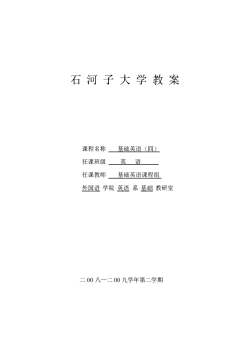
石河子大学教案课程名称基础英语 (四)英语任课班级任课教师基础英语课程组外国语学院英语系基础教研室二00八一二00九学年第二学期
石 河 子 大 学 教 案 课程名称 基础英语(四) 任课班级 英 语 任课教师 基础英语课程组 外国语 学院 英语 系 基础 教研室 二 00 八—二 00 九学年第二学期
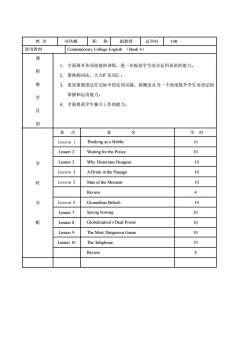
姓名刘凤峨职称副教授总学时108使用教材Contemporary College English(Book 4)课全面展开各项技能的训练,进一步提高学生综合运用英语的能力。1.程2.借助构词法,大力扩充词汇。教更加重视语法在交际中的实用功能,按概念从另一个角度提升学生对语法的3.掌握和运用能力。学4.全面提高学生独立工作的能力。目的章名章次学时10Lesson 1Thinking as a Hobby10Lesson 2Waitingfor thePolice10 Lesson 3Why Historians Disagree学10Lesson4A Drink in the Passage10时Lesson 5Man of the Moment4Review10分Lesson 6Groundless Beliefs10Lesson 7Spring Sowing配10Lesson 8Globalization's Dual Power10Lesson 9The Most Dangerous Game10Lesson 10The Telephone4Review
姓 名 刘凤峨 职 称 副教授 总学时 108 使用教材 Contemporary College English (Book 4) 课 程 教 学 目 的 1. 全面展开各项技能的训练,进一步提高学生综合运用英语的能力。 2. 借助构词法,大力扩充词汇。 3. 更加重视语法在交际中的实用功能,按概念从另一个角度提升学生对语法的 掌握和运用能力。 4. 全面提高学生独立工作的能力。 学 时 分 配 章 次 章 名 学 时 Lesson 1 Thinking as a Hobby 10 Lesson 2 Waiting for the Police 10 Lesson 3 Why Historians Disagree 10 Lesson 4 A Drink in the Passage 10 Lesson 5 Man of the Moment 10 Review 4 Lesson 6 Groundless Beliefs 10 Lesson 7 Spring Sowing 10 Lesson 8 Globalization’s Dual Power 10 Lesson 9 The Most Dangerous Game 10 Lesson 10 The Telephone 10 Review 4
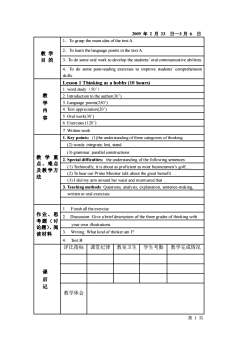
2009年2月23日—3月6日1.To grasp the main idea ofthe textA2.To learn the languagepoints in thetextA教学目的3.To do someoral work todevelop the students'oral communicative abilities4. To do some post-reading exercises to improve students comprehensionskills.Lesson 1Thinking as a hobby (10 hours)1. word study (50')教2.Introduction to theauthor(30)学3.Languagepoints(250")内4.Text appreciation(20')5.Oral work(30)容6.Exercises (120)7.Written work1.Keypoints:(1)theunderstanding of three categories ofthinking(2) words: integrate, lest, stand(3) grammar: parallel constructions教学重2. Special difficulties: the understanding of the following sentences:点、难点(1) Technically, it is about as proficient as most businessmen's golf,及教学方(2)TohearourPrimeMinistertalkaboutthegreatbemefit法(3)I slidmyarm around herwaistand murmured that3.Teachingmethods:Questions, analysis,explanation, sentence-makingwritten or oral exercises1.Finish all the exercise作业、思2Discussion:Givea brief description ofthe threegrades of thinkingwith考题(讨yourown illustrations论题)、阅3Writing: What kind of thinker am I?读材料4.Text B教室卫生评比指标课堂纪律学生考勤教学完成情况课后记教学体会第1页
2009 年 2 月 23 日—3 月 6 日 教 学 目 的 1.To grasp the main idea of the text A. 2.To learn the language points in the text A. 3.To do some oral work to develop the students’ oral communicative abilities. 4.To do some post-reading exercises to improve students’ comprehension skills. 教 学 内 容 Lesson 1 Thinking as a hobby (10 hours) 1. word study(50’) 2. Introduction to the author(30’) 3. Language points(250’) 4. Text appreciation(20’) 5. Oral work(30’) 6. Exercises (120’) 7. Written work 教学重 点、难点 及教学方 法 1. Key points:(1)the understanding of three categories of thinking (2) words: integrate, lest, stand (3) grammar: parallel constructions 2. Special difficulties:the understanding of the following sentences: (1) Technically, it is about as proficient as most businessmen’s golf, . (2) To hear our Prime Minister talk about the great bemefit . (3) I slid my arm around her waist and murmured that . 3. Teaching methods: Questions, analysis, explanation, sentence-making, written or oral exercises 作业、思 考题(讨 论题)、阅 读材料 1. Finish all the exercise 2. Discussion: Give a brief description of the three grades of thinking with your own illustrations 3. Writing: What kind of thinker am I? 4. Text B 课 后 记 评比指标 课堂纪律 教室卫生 学生考勤 教学完成情况 教学体会 第 1 页
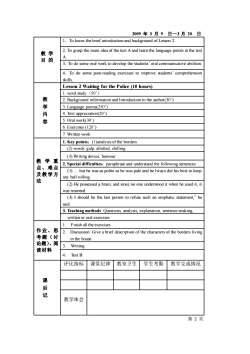
2009年3月9日一3月20日1.Toknowthe brief introduction and background of Lesson 22.To grasp the main idea of the text A and learn the language points in the text教学A目的3.Todo some oral work todevelopthe studentsoral communicative abilities4.To do some post-reading exercises to improve studentscomprehensionskills.Lesson2WaitingforthePolice(10hours)1.word study(50)教2.Background information and Introduction to the author(30')学3.Languagepoints(250")内4.Text appreciation(20)5.Oral work(30*)容6.Exercises (120)7. Written work1.Key points:(1)analysis of the borders(2) words: gulp, allotted, chilling(3) Writing device: humour教学重2.Special difficulties:paraphrase and understand the following sentences点、难点(1)... but he was as polite as he was pale and he lways did his best to keep及教学方anyball rolling法(2) He possessed a brain, and since no one understood it when he used it, itwas resented(3) I should be the last person to refute such an emphatic statement," hesaid.3. Teaching methods: Questions, analysis, explanation, sentence-making.written or oral exercises1.Finish all the exercises作业、思2Discussion: Give a brief description of the characters of the borders living考题(讨in the house论题)、阅3Writing:读材料4. Text B评比指标课堂纪律教室卫生学生考勤教学完成情况课后记教学体会第2页
2009 年 3 月 9 日—3 月 20 日 教 学 目 的 1.To know the brief introduction and background of Lesson 2. 2.To grasp the main idea of the text A and learn the language points in the text A. 3.To do some oral work to develop the students’ oral communicative abilities. 4.To do some post-reading exercises to improve students’ comprehension skills. 教 学 内 容 Lesson 2 Waiting for the Police (10 hours) 1. word study(50’) 2. Background information and Introduction to the author(30’) 3. Language points(250’) 4. Text appreciation(20’) 5. Oral work(30’) 6. Exercises (120’) 7. Written work 教学重 点、难点 及教学方 法 1. Key points:(1)analysis of the borders (2) words: gulp, allotted, chilling (3) Writing device: humour 2. Special difficulties:paraphrase and understand the following sentences: (1) . but he was as polite as he was pale and he lways did his best to keep any ball rolling. (2) He possessed a brain, and since no one understood it when he used it, it was resented. (3) I should be the last person to refute such an emphatic statement,” he said. 3. Teaching methods: Questions, analysis, explanation, sentence-making, written or oral exercises 作业、思 考题(讨 论题)、阅 读材料 1. Finish all the exercises 2. Discussion: Give a brief description of the characters of the borders living in the house 3. Writing: 4. Text B 课 后 记 评比指标 课堂纪律 教室卫生 学生考勤 教学完成情况 教学体会 第 2 页
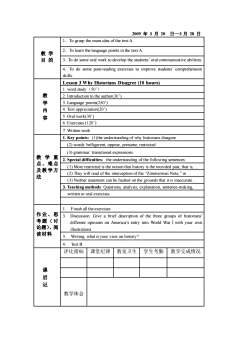
2009年3月20日一3月28日To grasp the main idea of the text A1.2..To learn the language points in the text A教学目的3.To do someoral work todevelop the students'oral communicative abilities4. To do some post-reading exercises to improve students comprehensionskills.Lesson 3 Why Historians Disagree (10 hours)1.word study (50")教2. Introduction to the author(30)学3.Languagepoints(250")内4.Textappreciation(20')5.Oral work(30)容6.Exercises (120)7.Written work1. Key points: (1)the understanding of why historians disagree(2) words: belligerent, oppose, presume, restricted(3) grammar: transitional expressions教学重2. Special difficulties: the understanding of the following sentences:点、难点(1) More restricted is the notion that history is the recorded past, that is.及教学方(2)Theywill readof the interception of the“ZimmermanNote,"in法(3)Neither statement can befaulted on thegrounds that it is inaccurate3.Teachingmethods:Questions,analysis,explanation,sentence-makingwritten or oral exercises1.Finish all the exercises作业、思3Discussion:Give a brief description of the three groups of historians考题(讨different opinionsonAmerica's entry into World WarI withyour own论题)、阅illustrations读材料3.Writing: what is your view on history?4.Text B教室卫生评比指标课堂纪律学生考勤教学完成情况课后记教学体会
2009 年 3 月 20 日—3 月 28 日 教 学 目 的 1.To grasp the main idea of the text A. 2.To learn the language points in the text A. 3.To do some oral work to develop the students’ oral communicative abilities. 4.To do some post-reading exercises to improve students’ comprehension skills. 教 学 内 容 Lesson 3 Why Historians Disagree (10 hours) 1. word study(50’) 2. Introduction to the author(30’) 3. Language points(250’) 4. Text appreciation(20’) 5. Oral work(30’) 6. Exercises (120’) 7. Written work 教学重 点、难点 及教学方 法 1. Key points:(1)the understanding of why historians disagree (2) words: belligerent, oppose, presume, restricted (3) grammar: transitional expressions 2. Special difficulties:the understanding of the following sentences: (1) More restricted is the notion that history is the recorded past, that is, . (2) They will read of the interception of the “Zimmerman Note,” in . (3) Neither statement can be faulted on the grounds that it is inaccurate. 3. Teaching methods: Questions, analysis, explanation, sentence-making, written or oral exercises 作业、思 考题(讨 论题)、阅 读材料 1. Finish all the exercises 3. Discussion: Give a brief description of the three groups of historians’ different opinions on America’s entry into World WarⅠwith your own illustrations 3. Writing: what is your view on history? 4. Text B 课 后 记 评比指标 课堂纪律 教室卫生 学生考勤 教学完成情况 教学体会
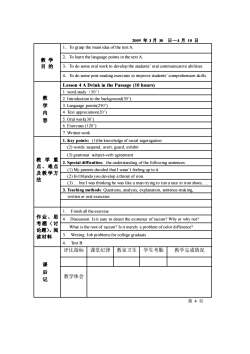
2009年3月300日一4月10日1.Tograspthe main idea ofthetextA2.To learn the languagepoints in the text A教学的3.目 Todo someoral worktodevelopthestudents'oral communicative abilities.4..Todosomepost-readingexercisestoimprovestudents'comprehensionskills.Lesson4ADrinkinthePassage(1ohours)1.word study(50)教2.Introduction tothebackground(30)学3. Language points(250)内4.Text appreciation(20)5.Oral work(30)容6.Exercises (120)7. Written work1.Keypoints:(l)theknowledgeofracial segeragation(2) words: suspend, avert, guard, exhibit(3) grammar: subject-verb agreement教学重2. Special difficulties:theunderstanding of the following sentences点、难点() My parents decided that I wasn't feeling up to it.111及教学方(2) In Orlando you develop a throat of iron法(3) ... but I was thinking he was like a man trying to run a race in iron shoes,..3. Teaching methods: Questions, analysis, explanation, sentence-making.writtenororal exercisesFinish all the exercise1作业、思4.Discussion:Isiteasytodetecttheexistenceofracism?Whyorwhynot考题(讨What is the root of racism?Is it merely aproblemof color difference?论题)、阅3Writing: Job problems for college graduats读材料4.Text B教室卫生评比指标课堂纪律学生考勤教学完成情况课后教学体会记第4页
2009 年 3 月 30 日—4 月 10 日 教 学 目 的 1.To grasp the main idea of the text A. 2.To learn the language points in the text A. 3.To do some oral work to develop the students’ oral communicative abilities. 4.To do some post-reading exercises to improve students’ comprehension skills. 教 学 内 容 Lesson 4 A Drink in the Passage (10 hours) 1. word study(50’) 2. Introduction to the background(30’) 3. Language points(250’) 4. Text appreciation(20’) 5. Oral work(30’) 6. Exercises (120’) 7. Written work 教学重 点、难点 及教学方 法 1. Key points:(1)the knowledge of racial segeragation (2) words: suspend, avert, guard, exhibit (3) grammar: subject-verb agreement 2. Special difficulties:the understanding of the following sentences: (1) My parents decided that I wasn’t feeling up to it. (2) In Orlando you develop a throat of iron. (3) . but I was thinking he was like a man trying to run a race in iron shoes, . 3. Teaching methods: Questions, analysis, explanation, sentence-making, written or oral exercises 作业、思 考题(讨 论题)、阅 读材料 1. Finish all the exercise 4. Discussion: Is it easy to detect the existence of racism? Why or why not? What is the root of racism? Is it merely a problem of color difference? 3. Writing: Job problems for college graduats 4. Text B 课 后 记 评比指标 课堂纪律 教室卫生 学生考勤 教学完成情况 教学体会 第 4 页
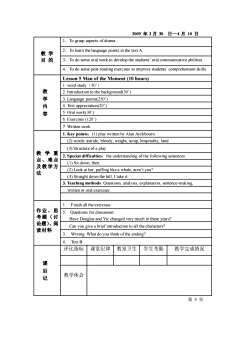
2009年3月30日一4月10日1.Tograsp aspects of drama2.To learn the language points in the text A.学教目的3. To do some oral work to develop the students'oral communicative abilities.4.Todo somepost-readingexercises to improve students'comprehension skills.Lesson5ManoftheMoment(1ohours)1. word study (50)教2.Introductiontothebackground(30)学3. Language points(250)内4. Text appreciation(20)容5. Oral work(30")6.Exercises(120°)7. Written work1. Key points:(1) playwritten by Alan Ayckbourn(2) words: astride, bloody,weight, scrap, hospitality, land(3)Structureofaplay教学重2. Special difficulties: the understanding of the following sentences:点、难点(1) Sit down, then及教学方(2) Look at her, puffing like a whale, aren't you?法(3)Straightdownthehill,Itakeit3.Teaching methods:Questions, analysis, explanation, sentence-makingwrittenororal exercises1Finishall theexercises作业、思5Questions for discussion考题(讨HaveDouglas andVic changed verymuch in theseyears?论题)、阅Canyougiveabrief introductiontoall thecharacters?读材料3Writing: What do you think of the ending?4.Text B评比指标课堂纪律教室卫生学生考勤教学完成情况课后教学体会记第5页
2009 年 3 月 30 日—4 月 10 日 教 学 目 的 1.To grasp aspects of drama. 2.To learn the language points in the text A. 3.To do some oral work to develop the students’ oral communicative abilities. 4.To do some post-reading exercises to improve students’ comprehension skills. 教 学 内 容 Lesson 5 Man of the Moment (10 hours) 1. word study(50’) 2. Introduction to the background(30’) 3. Language points(250’) 4. Text appreciation(20’) 5. Oral work(30’) 6. Exercises (120’) 7. Written work 教学重 点、难点 及教学方 法 1. Key points:(1) play written by Alan Ayckbourn (2) words: astride, bloody, weight, scrap, hospitality, land (3) Structure of a play 2. Special difficulties:the understanding of the following sentences: (1) Sit down, then. (2) Look at her, puffing like a whale, aren’t you? (3) Straight down the hill, I take it. 3. Teaching methods: Questions, analysis, explanation, sentence-making, written or oral exercises 作业、思 考题(讨 论题)、阅 读材料 1. Finish all the exercises 5. Questions for discussion: Have Douglas and Vic changed very much in these years? Can you give a brief introduction to all the characters? 3. Writing: What do you think of the ending? 4. Text B 课 后 记 评比指标 课堂纪律 教室卫生 学生考勤 教学完成情况 教学体会 第 5 页
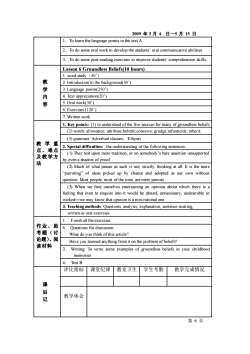
2009年5月4日一5月15日To learn the language points in the text A2.Todosomeoral worktodevelopthe students'oral communicative abilities3.Todosomepost-reading exercises to improve students'comprehension skillsLesson6Groundless Beliefs(10hours)1.word study(50)教2. Introduction to the background(30)学3.Languagepoints(250')内4.Text appreciation(20)5.Oral work(30")容6.Exercises(120)7. Written work1. Key points: () to understand of the five sources for many of groundless beliefs(2) words: allowance; attribute;belittle;conceive, grudge;infanticide; inherit;(3) grammer: Adverbial clauses, Ellipsis教学重2. Special difficulties: the understanding ofthe following sentences点、难点(I) They rest upon mere tradition,or on somebody'sbare assertion unsupported及教学方by evena shadow ofproof...法(2) Much of what passes as such is not, strictly, thinking at all. It is the mere"parroting”of ideas picked up by chance and adopted as our own withoutquestion. Most people, most of the time, are mere parrots.(3) When we find ourselves entertaining an opinion about which there is afeeling that even to enquire into it would be absurd unnecessary, undesirable orwicked-wemayknowthatopinion is a non-rational one3. Teaching methods: Questions, analysis, explanation, sentence-making.written or oral exercises1Finish all the exercises作业、思6Questions for discussion:考题(讨What do you think of this article?论题)、阅Haveyoulearned anythingfromit ontheproblemofbeliefs?读材料3.Writing To write some examples of groundless beliefs in your childhoodmemories4.Text B评比指标课堂纪律教室卫生学生考勤教学完成情况课后教学体会记第6页
2009 年 5 月 4 日—5 月 15 日 1.To learn the language points in the text A. 2.To do some oral work to develop the students’ oral communicative abilities. 3.To do some post-reading exercises to improve students’ comprehension skills. 教 学 内 容 Lesson 6 Groundless Beliefs(10 hours) 1. word study(50’) 2. Introduction to the background(30’) 3. Language points(250’) 4. Text appreciation(20’) 5. Oral work(30’) 6. Exercises (120’) 7. Written work 教学重 点、难点 及教学方 法 1. Key points:(1) to understand of the five sources for many of groundless beliefs (2) words: allowance; attribute;belittle;conceive; grudge;infanticide; inherit; (3) grammer: Adverbial clauses; Ellipsis 2. Special difficulties:the understanding of the following sentences: (1) They rest upon mere tradition, or on somebody’s bare assertion unsupported by even a shadow of proof. (2) Much of what passes as such is not, strictly, thinking at all. It is the mere “parroting” of ideas picked up by chance and adopted as our own without question. Most people, most of the time, are mere parrots. (3) When we find ourselves entertaining an opinion about which there is a feeling that even to enquire into it would be absurd, unnecessary, undesirable or wicked—we may know that opinion is a non-rational one. 3. Teaching methods: Questions, analysis, explanation, sentence-making, written or oral exercises 作业、思 考题(讨 论题)、阅 读材料 1. Finish all the exercises 6. Questions for discussion: What do you think of this article? Have you learned anything from it on the problem of beliefs? 3. Writing: To write some examples of groundless beliefs in your childhood memories 4. Text B 课 后 记 评比指标 课堂纪律 教室卫生 学生考勤 教学完成情况 教学体会 第 6 页
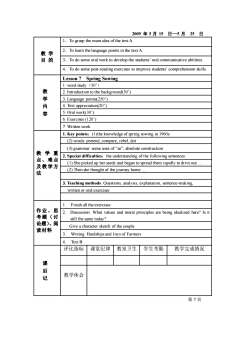
2009年5月155日—5月25日1.Tograsp the main idea of the text A2.To learn the language points in the text A教学目的3.Todo some oral work to develop the students'oral communicative abilities4.Todo somepost-readingexercises to improvestudents'comprehension skillsLesson7Spring Sowing1.word study (50')教2.Introductiontothebackground(30")学3.Language points(250)内4. Text appreciation(20)容5. Oral work(30")6.Exercises (120")7. Written work1.Keypoints:(1)theknowledgeofspring sowing in1960s(2) words: pretend, compare, rebel, dot(3)grammar:someuses of“as";absolute construction教学重2. Special difficulties: the understanding of the following sentences:点、难点(1) She picked up her seeds and began to spread them rapidly to drive out及教学方(2)Then she thought of the journey home法3. Teaching methods: Questions, analysis, explanation, sentence-making.writtenororal exercises1.Finishall theexercises作业、思2Discussion: What values and moral principles are being idealized here? Is it考题(讨still the same today?论题)、阅Giveacharactersketchof thecouple读材料3Writing: Hardships and Joys of Farmers4.Text B评比指标课堂纪律教室卫生学生考勤教学完成情况课后教学体会记第7页
2009 年 5 月 15 日—5 月 25 日 教 学 目 的 1.To grasp the main idea of the text A. 2.To learn the language points in the text A. 3.To do some oral work to develop the students’ oral communicative abilities. 4.To do some post-reading exercises to improve students’ comprehension skills. 教 学 内 容 Lesson 7 Spring Sowing 1. word study(50’) 2. Introduction to the background(30’) 3. Language points(250’) 4. Text appreciation(20’) 5. Oral work(30’) 6. Exercises (120’) 7. Written work 教学重 点、难点 及教学方 法 1. Key points:(1)the knowledge of spring sowing in 1960s (2) words: pretend, compare, rebel, dot (3) grammar: some uses of “as”; absolute construction 2. Special difficulties:the understanding of the following sentences: (1) She picked up her seeds and began to spread them rapidly to drive out . (2) Then she thought of the journey home . 3. Teaching methods: Questions, analysis, explanation, sentence-making, written or oral exercises 作业、思 考题(讨 论题)、阅 读材料 1. Finish all the exercises 2. Discussion: What values and moral principles are being idealized here? Is it still the same today? Give a character sketch of the couple 3. Writing: Hardships and Joys of Farmers 4. Text B 课 后 记 评比指标 课堂纪律 教室卫生 学生考勤 教学完成情况 教学体会 第 7 页
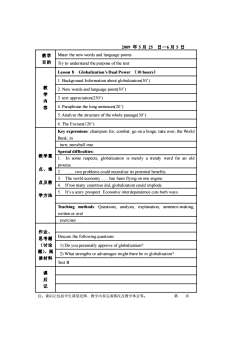
2009年5月25日—6月5日教学Mater the new words and language points目的Try to understand the purpose of the textLesson 8Globalization's Dual Power(10 hours)1.Background Informationaboutglobalization(30")教2.Newwords and languagepoint(50')学3. text appreciation(250)内4. Paraphrase the long sentences(20)容5.Analyzethestructureofthewholepassage(30)6. The Excises(120)Key expressions: champion for, combat, go on a binge; take over, the WorldBank, inturn,snowball intoSpecial difficulties:教学重1.In some respects,globalization is merely a trendyywordfor anoldprocess.点、难2....twoproblemscouldneutralizeitspotentialbenefits3...hasbeen flying on one engineTheworldeconomy.点及教4.If toomany countriesdid,globalization could implode5It's a scary prospect.Economic interdependence cuts both ways学方法Teaching methods:Questions, analysis, explanation, sentence-making.written or oralexercises作业、Discuss the following questions思考题(讨论1)Do youpersonally approve of globalization?题)、阅2) What strengths or advantages might there be in globalization?读材料Text B课后记第页注:课后记包括学生课堂纪律、教学内容完成情况及教学体会等
2009 年 5 月 25 日—6 月 5 日 教学 目的 Mater the new words and language points Try to understand the purpose of the text 教 学 内 容 Lesson 8 Globalization’s Dual Power (10 hours) 1. Background Information about globalization(30’) 2. New words and language point(50’) 3. text appreciation(250’) 4. Paraphrase the long sentences(20’) 5. Analyze the structure of the whole passage(30’) 6. The Excises(120’) 教学重 点、难 点及教 学方法 Key expressions: champion for; combat; go on a binge; take over; the World Bank; in turn; snowball into Special difficulties: 1. In some respects, globalization is merely a trendy word for an old process. 2. .two problems could neutralize its potential benefits. 3. The world economy.has been flying on one engine. 4. If too many countries did, globalization could implode. 5. It’s a scary prospect. Economic interdependence cuts both ways. Teaching methods: Questions, analysis, explanation, sentence-making, written or oral exercises 作业、 思考题 (讨论 题)、阅 读材料 Discuss the following questions 1) Do you personally approve of globalization? 2) What strengths or advantages might there be in globalization? Text B 课 后 记 注:课后记包括学生课堂纪律、教学内容完成情况及教学体会等。 第 页
按次数下载不扣除下载券;
注册用户24小时内重复下载只扣除一次;
顺序:VIP每日次数-->可用次数-->下载券;
- 《大学基础英语》课程教学资源(授课教案)基础英语教案二.doc
- 《大学基础英语》课程教学资源(授课教案)基础英语教案一.doc
- 《大学基础英语》课程教学资源(教学大纲)基础英语四.doc
- 《大学基础英语》课程教学资源(教学大纲)基础英语三.doc
- 《大学基础英语》课程教学资源(教学大纲)基础英语二.doc
- 《大学基础英语》课程教学资源(教学大纲)基础英语一.doc
- 《大学基础英语》课程教学资源(试卷习题)2005-2010英语专业四级真题(无答案).doc
- 《大学基础英语》课程教学资源(教学大纲)英语专业四级语法总结.doc
- 《大学基础英语》课程教学资源(教学大纲)英语专业四级词.doc
- 《大学基础英语》课程教学资源(教学大纲)英语专业四级考试大纲.doc
- 《大学英语教程》课程教材配套电子教案(PPT教学课件,北大版)第四册 第五单元.pptx
- 《大学英语教程》课程教材配套电子教案(PPT教学课件,北大版)第一册 第一单元.pptx
- 《大学英语教程》课程教材配套电子教案(PPT教学课件,北大版)第三册 第七单元.pptx
- 《大学英语教程》课程教材配套电子教案(PPT教学课件,北大版)第三册 第八单元.pptx
- 《大学英语教程》课程教材配套电子教案(PPT教学课件,北大版)第三册 第二单元.pptx
- 《大学英语教程》课程教材配套电子教案(PPT教学课件,北大版)第三册 第三单元.pptx
- 《大学英语教程》课程教材配套电子教案(PPT教学课件,北大版)第三册 第一单元.pptx
- 《大学英语教程》课程教材配套电子教案(PPT教学课件,北大版)第一册 第二单元.pptx
- 《大学英语教程》课程教材配套电子教案(PPT教学课件,北大版)第四册 第四单元.pptx
- 《大学英语教程》课程教材配套电子教案(PPT教学课件,北大版)第一册 第三单元.pptx
- 《大学基础英语》课程教学资源(授课教案)基础英语教案三.doc
- 《大学基础英语》课程PPT教学课件(一)Lesson 11 The Midnight Visitor.ppt
- 《大学基础英语》课程PPT教学课件(一)Lesson 7 Mandela's Garden.ppt
- 《大学基础英语》课程PPT教学课件(一)Lesson 5 Angels on a Pin.ppt
- 《大学基础英语》课程PPT教学课件(一)Lesson 8 My Personal Manager.ppt
- 《大学基础英语》课程PPT教学课件(一)Lesson Three Message of the Land.ppt
- 《大学基础英语》课程PPT教学课件(一)Lesson one Half A Day.ppt
- 《大学基础英语》课程PPT教学课件(一)Lesson 2 Going Home.ppt
- 《大学基础英语》课程PPT教学课件(二)Lesson Nine Quick Fix Society.ppt
- 《大学基础英语》课程PPT教学课件(二)Lesson Eleven You Have To Get Me Out Of Here.ppt
- 《大学基础英语》课程PPT教学课件(二)Lesson Ten The Richer, the Poorer.ppt
- 《大学基础英语》课程PPT教学课件(二)Lesson Seven The Greatest Invention.ppt
- 《大学基础英语》课程PPT教学课件(二)Lesson Five Say Yes.ppt
- 《大学基础英语》课程PPT教学课件(二)Lesson four The Nightingale and the Rose.ppt
- 《大学基础英语》课程PPT教学课件(二)Lesson One Another Schol Year- What For?.ppt
- 《大学基础英语》课程PPT教学课件(二)Lesson Two Maheegun My Brother.ppt
- 《大学基础英语》课程PPT教学课件(三)Lesson 08 We’re Only Human Laura Schlessinger.ppt
- 《大学基础英语》课程PPT教学课件(三)Lesson 07 The Rivals Martin Armstrong.ppt
- 《大学基础英语》课程PPT教学课件(三)Lesson 05 Twelve Angry Men(Part One).ppt
- 《大学基础英语》课程PPT教学课件(三)Lesson 06 Twelve Angry Men(Part Two).ppt
